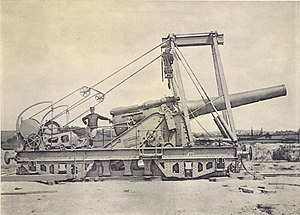Railway gun
The Canon de 240 TR Mle 1903 sur affût-truck Mle 1914 was a French railway gun and siege gun used by the French Army during World War I.
History
Before the First World War, the doctrine of the French Army was geared towards a war of rapid maneuver. Although the majority of combatants had heavy field artillery prior to the outbreak of the First World War, none had adequate numbers of heavy guns in service and once the Western Front stagnated and trench warfare set in the light field guns that the combatants went to war with were beginning to show their limitations when facing an enemy who was now dug into prepared positions. Indirect fire, interdiction and counter-battery fire emphasized the importance of long-range heavy artillery. Since aircraft of the period were not yet capable of carrying large diameter bombs the burden of delivering heavy firepower fell on the artillery. Two sources of heavy artillery suitable for conversion to field use were surplus coastal defense guns and naval guns.[2]
However, a paradox faced artillery designers of the time; while large caliber naval guns were common, large caliber land weapons were not due to their weight, complexity, and lack of mobility. Large caliber field guns often required extensive site preparation because the guns had to be broken down into multiple loads light enough to be towed by a horse team or the few traction engines of the time and then reassembled before use. Building a new gun could address the problem of disassembling, transporting and reassembling a large gun, but it did not necessarily address how to convert existing heavy weapons to make them more mobile. Rail transport proved to be the most practical solution because the problems of heavy weight, lack of mobility and reduced setup time were addressed.[2]
World War I
The Canon de 240 TR Mle 1903 was assigned to units of the ALGP (artillerie lourde à grande puissance) during World War I. At first, they were organized in 4 groups of 2 batteries of 2 guns per battery. Later the guns were reorganized into 2 groups 1 with 3 batteries and 2 with 2 batteries of 3 guns with 1 spare.[5] When the war ended there were 8 guns left in service.[1]






